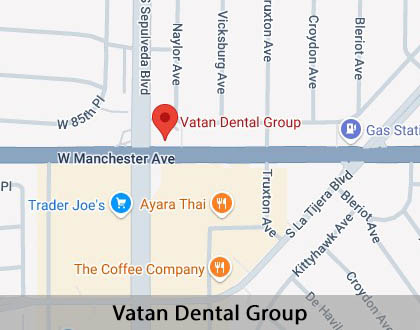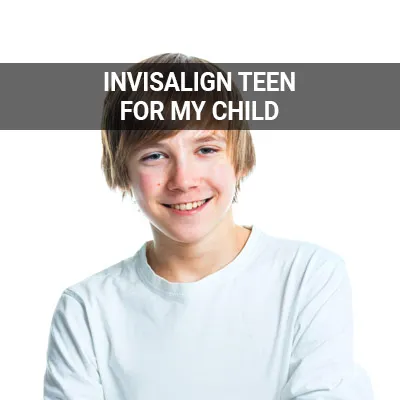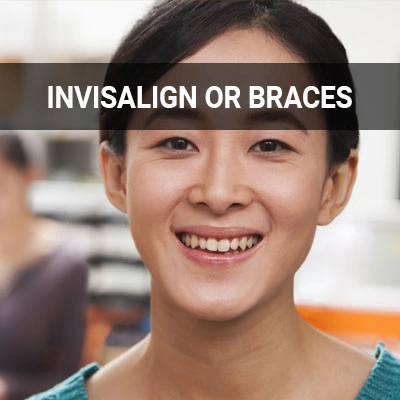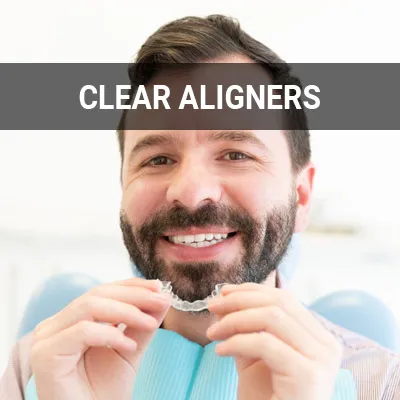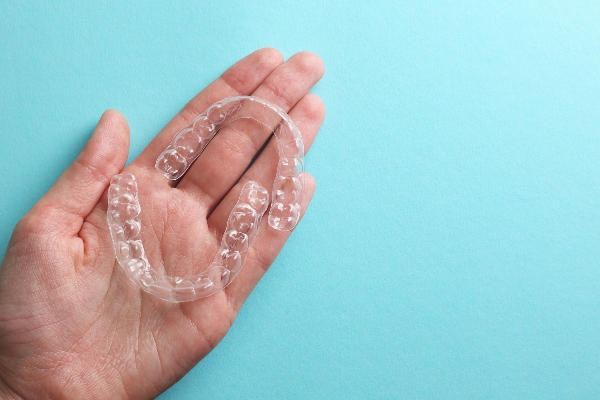Invisalign vs Traditional Braces Los Angeles, CA
When deciding between traditional metal braces or Invisalign to help correct dental issues, you may have some questions about which to choose. We can help you consider the various differences between regular braces and Invisalign before making a decision. While both methods straighten teeth, each orthodontic option does so in different ways.
Vatan Dental Group in Los Angeles can help patients choose between Invisalign or braces. Our team can help you make the right decision for your dental needs. Call us at (310) 906-1300 to schedule a consultation or learn more about our services.
Major Differences
When considering Invisalign and traditional braces, patients should first realize that no one treatment is better than the other. The right treatment will vary on a case-by-case basis. The first step to determining what is best for a patient is an accurate diagnosis. From then on, Vatan Dental Group can consider the patient's treatment process goals, the patient's lifestyle needs, and more.
The main distinguishing factor between Invisalign and traditional braces is visibility. Invisalign is a more discreet option, while traditional braces will remain evident in the patient's mouth. Additionally, Invisalign trays are removable, while traditional braces will remain attached to the patient's teeth. Consequently, patients with traditional braces may need to make some dietary changes during their treatment. In any case, both Invisalign and traditional braces will require patients to maintain a consistent oral hygiene routine and wear retainers after completion.
“When considering Invisalign and traditional braces, patients should first realize that no one treatment is better than the other.”
Treatment Time
Though overall treatment time with Invisalign depends on the severity of the condition, most patients complete treatment within 10 to 24 months. However, patients with more misaligned bites or crooked teeth will likely need to wear their aligners for a more extended period. Some may also require further, smaller refinements for a few months after completing treatment. On the other hand, adults who had braces as children may complete treatment in around 10 weeks.
Similarly, treatment time with traditional braces will depend on various factors. These include the severity of the patient's case, the amount of room inside their mouth, and how far their teeth must travel. It is also essential to consider how healthy the patient's teeth, gums, and supporting bone are. On average, however, braces will typically remain in place for one to three years. In both cases, patients may extend their treatment time by not following instructions closely.
“…patients may extend their treatment time by not following instructions closely.”
Efficacy
According to at least one meta-analysis, patients prefer clear aligners like Invisalign over metal braces for their discreet nature, comfort, and ease of maintaining oral hygiene. Multiple studies in the meta-analysis also found that patients tended to have a shorter treatment time with Invisalign than with traditional braces.
However, it is crucial to note that Invisalign lacks the precision of traditional braces, making them better suited for patients with less severe orthodontic issues. While clear aligners are an overall effective means of addressing malocclusion, traditional braces can more significantly shift the teeth and jaw. At Vatan Dental Group, we take all the necessary steps to provide our patients with the most effective, personalized treatment possible.
“How effective are Invisalign and traditional braces?”
Check out what others are saying about our dental services on Yelp: Invisalign vs Traditional Braces in Los Angeles, CA
Eating
As stated by Healthline, patients should keep their Invisalign trays in their mouth for 20 to 22 hours per day. These trays should only be removed for eating, drinking anything that is not clear water, or performing their oral hygiene routines. Since Invisalign trays do not involve any wires or brackets, the treatment itself does not necessitate any dietary changes. However, patients should still brush their teeth before putting their aligners back on to prevent staining.
On the other hand, patients will need to adjust their diets while wearing braces. This is because the brackets are sensitive to damage, and patients must take care not to cause them to separate from the tooth. Thus, it is necessary to avoid any foods that are too hard, sticky, or chewy, such as popcorn, chewing gum, hard crackers, and more. It is also essential to limit sugary foods and drinks, as the combination of sugar and saliva may lead to an excess of plaque that is hard to remove.
“What can I eat when I have braces?”
Questions Answered on This Page
Q. What are the differences between Invisalign and traditional braces?
Q. How long is treatment time with traditional braces and Invisalign?
Q. How effective are Invisalign and traditional braces?
Q. What can I eat when I have braces?
Q. What are the aesthetic differences between braces and Invisalign?
People Also Ask
Q. What are some examples of purely cosmetic procedures?
Q. How can someone find the right Invisalign Dentist?
Q. Are clear aligners a time-saving treatment?
Q. When are braces more effective than Invisalign?
Q. What should people consider before seeking cosmetic dental care?
Aesthetic Differences
Traditional braces consist of metal wires, brackets, and rubber bands. For many people, this can be a source of embarrassment that leads them to feel self-conscious while smiling or engaging in activities with peers. Braces stay affixed to the teeth throughout the entire course of treatment. This can make eating some foods more challenging and may make brushing and flossing more difficult, to ensure all food remnants remain cleaned from the braces to prevent cavities.
In contrast, Invisalign trays are clear and thin, making them nearly invisible. This treatment is popular and can boost a patient's self-esteem while they complete orthodontic treatment. Many patients appreciate that Invisalign aligners can be removed when eating, brushing, flossing, or for short periods for work or social occasions.
“…Invisalign trays are clear and thin, making them nearly invisible.”
Frequently Asked Questions
Q. Which is more comfortable: braces or Invisalign?
A. Initial discomfort comes when placing and adjusting braces. The brackets and wires can also irritate sensitive mouth tissues and may cause the occasional mouth sore. The good news is, this is temporary. Once patients become accustomed to their braces and adjustments, the pain goes away. For the most part, Invisalign trays remain comfortable and custom-made to fit each individual's mouth. Some patients may experience initial discomfort when switching to a new set of aligners as the teeth shift into new positions.
Q. Which takes longer: braces or Invisalign?
A. The treatment time varies for each individual, depending on the issues that need to be corrected. For most patients, braces must be worn for 18-24 months. Invisalign treatment remains typically shorter, and many patients can achieve their desired results within 6-18 months, depending on each patient and the issues that need to be addressed.
Q. Are there dietary restrictions with braces and Invisalign?
A. When wearing braces, patients will need to refrain from eating certain foods and snacks, such as nuts, sticky foods, and gum. With Invisalign, no dietary restrictions apply. With trays removed when eating and drinking, no worries remain regarding damaging them with hard or sticky foods. Whether you opt for braces or Invisalign, you must brush your teeth at least twice daily and avoid food and drink high in sugars.
Q. Which is more expensive: Invisalign or braces?
A. The cost of braces and Invisalign treatment varies, depending on the issue that needs correcting and the length of treatment time. Every insurance plan is different. Check with your insurance provider for coverage information before seeking treatment.
Q. How often will I have to see my Invisalign or braces provider?
A. Patients with traditional braces usually see their braces provider about every four weeks for adjustment appointments. Invisalign wearers typically visit their Invisalign provider about every four to six weeks to ensure their treatment is progressing as planned. Invisalign appointments are quicker traditional braces since there is no need for adjustment.
Invisalign® Terminology
Call Us Today
A beautiful smile is not just a matter of aesthetics — it can also greatly impact your oral health. Whether you need Invisalign or traditional braces, Vatan Dental Group can help. Call us today at 310-906-1300 to schedule an appointment or learn more about our services.
Helpful Related Links
- American Dental Association (ADA). Glossary of Dental Clinical Terms. 2025
- American Academy of Cosmetic Dentistry® (AACD). Home Page. 2025
- Invisalign®. How Invisalign Works. 2025
- Invisalign®. Take the Smile Assessment. 2025
- WebMD. WebMD’s Oral Care Guide. 2025
About our business, license, and website security
- Vatan Dental Group was established in 2012.
- We accept the following payment methods: American Express, Cash, Check, Discover, MasterCard, and Visa
- We serve patients from the following counties: Los Angeles County
- We serve patients from the following cities: Los Angeles, Inglewood, Westchester, Marina del Rey, Playa del Rey, Playa Vista, Culver City, Fox Hills, Hawthorne, El Segundo and Santa Monica
- CA (License #49259). View License Information and Specifics
- National Provider Identifier Database (1740278662). View NPI Registry Information
- Norton Safe Web. View Details
- Trend Micro Site Safety Center. View Details
Back to top of Invisalign vs Traditional Braces

